INTERNACIONAL
ICE director says Portland facility faces violence with ‘little help from local police’

NEWYou can now listen to Fox News articles!
Federal immigration officials say their Portland, Oregon, facility has come under nightly attack, with little help from local police because of political directives from city leaders.
In an exclusive interview with Fox News’ Bill Melugin, Cammila Wamsley, director of Portland’s ICE office, said the facility has faced violence for more than 100 consecutive nights, with Portland police largely absent under guidance from the mayor and city council.
«I just, I can’t figure out what’s happening at the FDA. I’m totally baffled by it,» Wamsley said, describing her frustration at seeing federal staff attacked outside the building while officers inside lack jurisdiction to intervene. «It’s frustrating for us to watch people be attacked on the street and know that we don’t have the authority to be able to really step in unless there’s some nexus to federal law.»
She said nightly protests have escalated beyond chants and signs, with bottle rockets striking the ICE building, rocks shattering windows, lasers targeting officers’ eyes and barricades blocking vehicles.
ANTI-ICE PORTLAND RIOTERS WITH GUILLOTINE CLASH WITH POLICE IN WAR-LIKE SCENES
People protest outside a U.S. Immigration and Customs Enforcement facility as federal agents watch from the rooftop in Portland, Ore., Wednesday. (AP Photo/Amanda Loman)
Wamsley said protesters have followed ICE staff members home and doxxed at least six employees.
«Later, towards the evening and around dark, there are a lot of folks that come up dressed in all black,» she explained. «They are here to wreak havoc. They’ll block our cars, throw paint, damage property and even try to follow our folks home.»
She warned that when crowds swell quickly, the violence becomes more dangerous.
ICE DIRECTOR REVEALS DANGEROUS NIGHTLY ANTIFA ‘BATTLE’ AS TRUMP PREPARES FEDERAL DEPLOYMENT TO PORTLAND
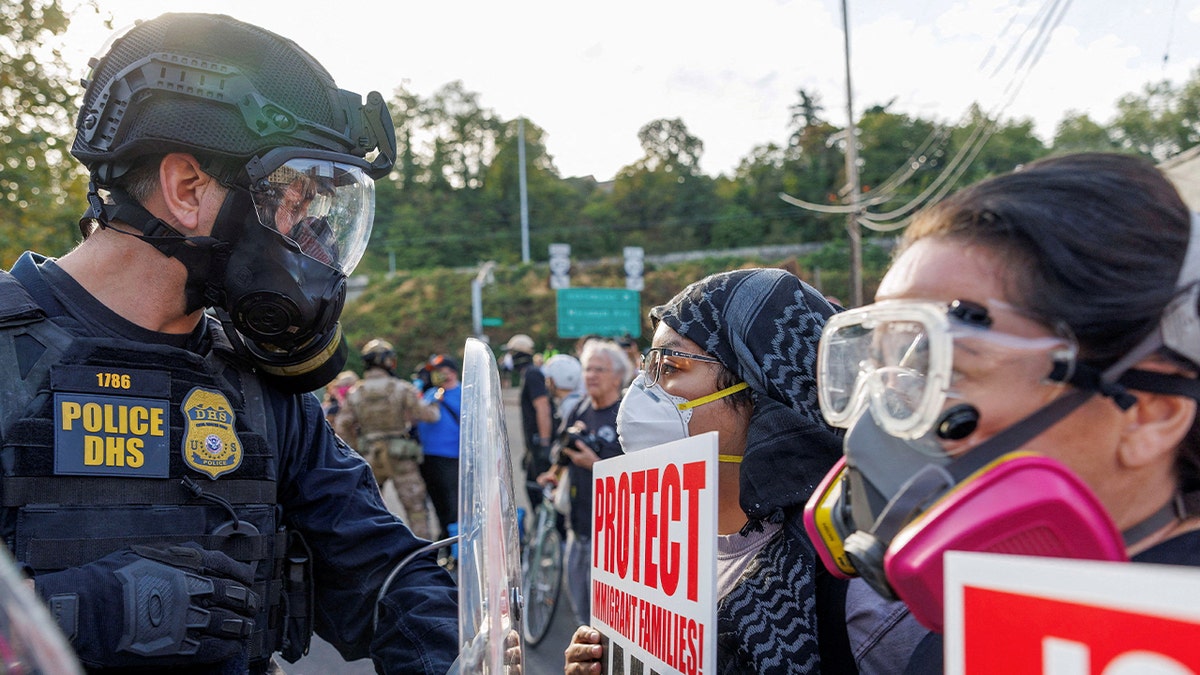
A Federal Protective Service officer stands guard in front of demonstrators as protests against Immigration and Customs Enforcementdraw hundreds to the ICE headquarters in south Portland, Ore., Sunday. (John Rudoff/Reuters)
«We’ve seen it before. The folks here can go from a crowd of 50 to a crowd of 1,000 in 30 minutes,» she explained. «Sometimes we only have 20 officers here. We would not be able to defend the building with that show of force.»
Wamsley said the Portland Police Department has been slow to respond — and sometimes doesn’t respond at all — because of city policy. She explained that assaults have occurred outside and across the street from the building, but police have either taken too long to arrive or not shown up at all.
«That is not the stance they would take six blocks from here, but it is the stance they take with us because of guidance from the mayor and city council,» Wamsley said.
PORTLAND MAYOR DOUBLES DOWN ON SANCTUARY STATUS AFTER VIOLENT ANTI-ICE RIOT
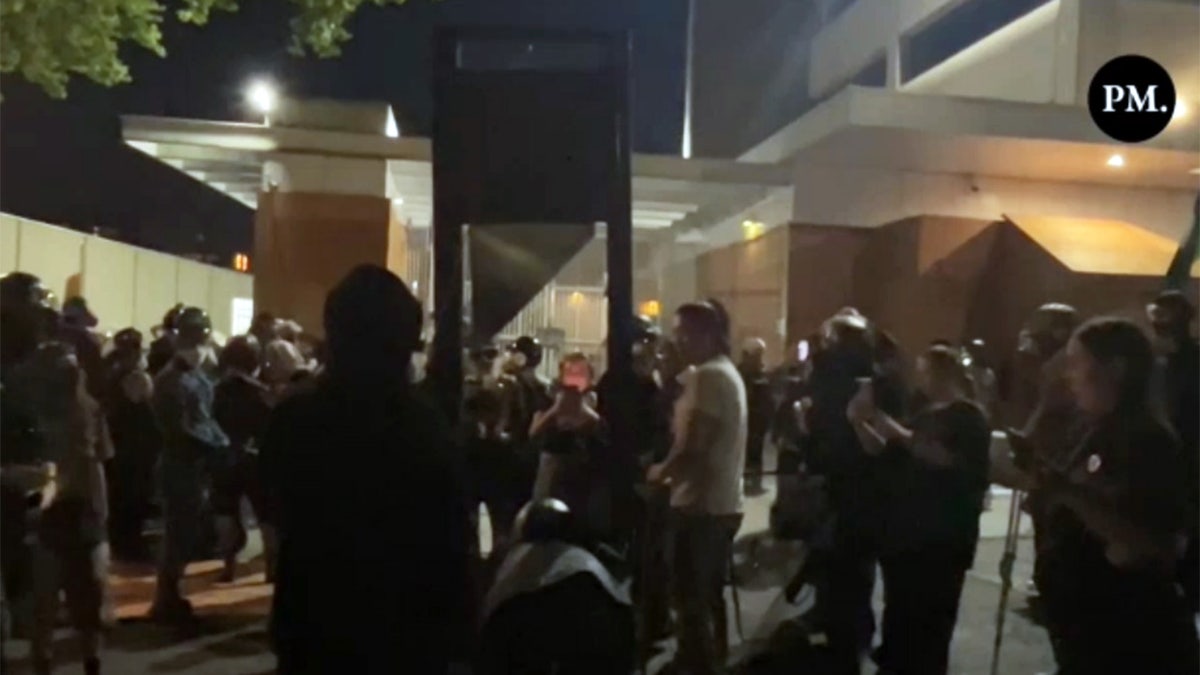
Anti-ICE protesters roll out a guillotine in front of the ICE field office in Portland, Ore. (X/@KatieDaviscourt)
Fox News Digital has reached out to the Portland mayor’s office and police department for comment.
Still, Wamsley said ICE staff remain committed to their mission despite the unrest.
«The people that work here are here to serve the American public,» she said. «They are here to enforce the same immigration laws we’ve had in place since the 1950s. Nothing has changed in that regard. We come to work every day. We do our job the way we have been doing it, and we’ll continue to do that.»
PORTLAND RAMPS UP PRESSURE ON ICE BUILDING WITH LAND USE VIOLATION NOTICE
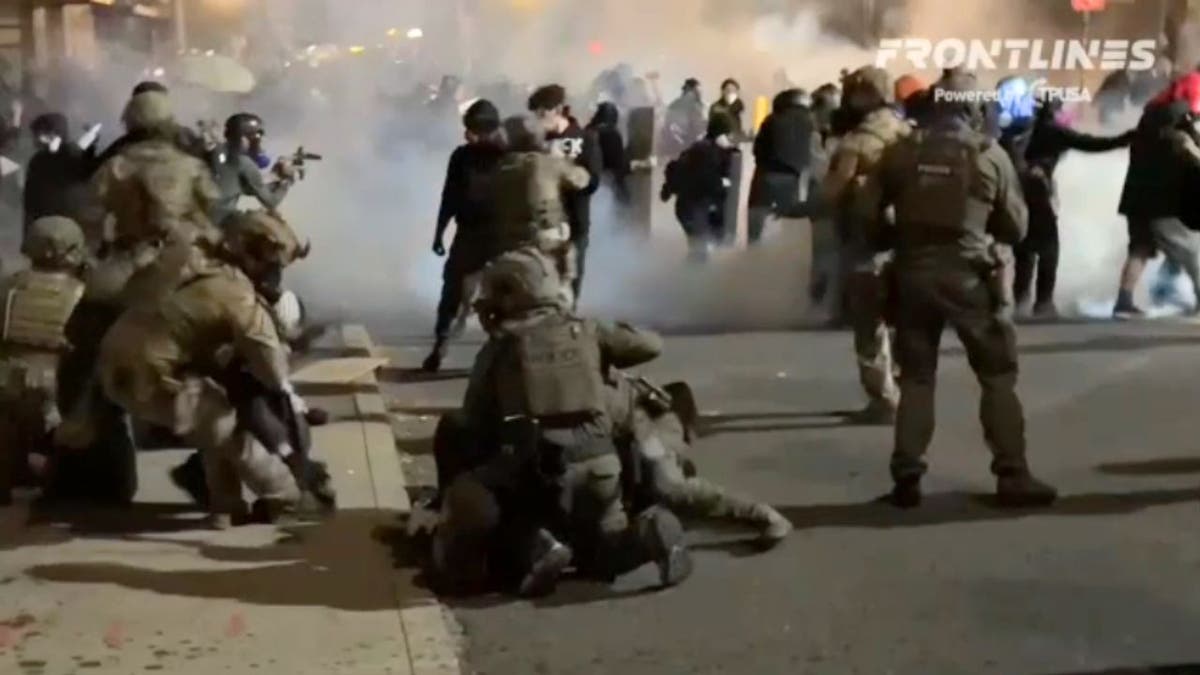
Federal agents arrest a person outside an Immigration and Customs Enforcement facility in Portland, Ore., in June. (X/@choeshow/@frontlinesTPUSA)
Todd Rignel, assistant special agent for Homeland Security Investigations (HSI) in Oregon, said federal agencies are targeting Antifa-linked groups they blame for organizing much of the unrest.
«They’re not just facing HSI. They’re facing the FBI, ATF, DEA, IRS — all of these agencies,» he said. «That’s a force to be reckoned with.»
Portland remains a flashpoint for unrest with the ICE facility at the center of nightly confrontations.
President Donald Trump announced plans to send 200 National Guard troops to Portland to support immigration authorities. Officials said the troops would be stationed near protest areas.
CLICK HERE TO DOWNLOAD THE FOX NEWS APP
The warnings follow an attack on an ICE facility in Dallas Sept. 24. Authorities said two detainees were killed and another was hospitalized after a gunman opened fire before dying of a self-inflicted gunshot.
Investigators said shell casings recovered bore an «ANTI-ICE» message.
Fox News Digital’s Madison Colombo contributed to this report.
oregon,homeland security,immigration,antifa,vandalism
INTERNACIONAL
The agency staff Vought might recommend cutting and whether the cuts will be permanent

NEWYou can now listen to Fox News articles!
Office of Management and Budget (OMB) chief Russell Vought and President Donald Trump are in the midst of mapping out cuts to the federal government after lawmakers on Capitol Hill failed to reach a funding bill agreement early Wednesday morning.
Trump set the stage in the lead-up to the shutdown that the federal government is likely to see staffing and program cuts during the shutdown, adding in a message Thursday to Truth Social that many federal agencies are a «political SCAM.»
«I have a meeting today with Russ Vought, he of PROJECT 2025 Fame, to determine which of the many Democrat Agencies, most of which are a political SCAM, he recommends to be cut, and whether or not those cuts will be temporary or permanent,» Trump posted.
HERE’S WHAT TRUMP WANTS TO DO TO RESHAPE THE FEDERAL GOVERNMENT DURING THE SHUTDOWN
«I can’t believe the Radical Left Democrats gave me this unprecedented opportunity. They are not stupid people, so maybe this is their way of wanting to, quietly and quickly, MAKE AMERICA GREAT AGAIN!»
Office of Management and Budget chief Russell Vought and President Donald Trump are in the midst of mapping out cuts to the federal government after lawmakers on Capitol Hill failed to reach a funding bill agreement. (Alex Brandon/The Associated Press )
Fox News Digital spoke with Richard Stern, the Heritage Foundation’s director of the Grover M. Hermann Center for the Federal Budget, Thursday morning to discuss which agencies the OMB chief would likely target for staffing cuts and if such cuts would be permanent.
How a shutdown enables cuts
Stern explained to Fox Digital that there are a pair of overlapping issues that lead to the government’s staffing size. Agencies are required by various laws to provide certain services to citizens. And, separately, appropriation bills set funding floors on how much money an agency has available to spend on staff payroll.
During a shutdown, however, there is a lapse in funding, meaning agencies do not have «payroll floors from the funding bill,» leaving the executive branch with discretion on how to continue providing required services to citizens, he explained.
«Because the funding bills set effective floors per salary spending, that tends to dictate how many people work for the agencies. In the event of a shutdown, the only requirement on the administration is to ensure that the agencies provide the services and whatnot that are required by law. But those laws don’t say you need, you know, 100 staffers to write a grant or only one staffer,» Stern told Fox Digital in a phone interview.
WHITE HOUSE PREPARES FOR ‘IMMINENT’ FEDERAL LAYOFFS AFTER DEMOCRATS FORCE GOVERNMENT SHUTDOWN
«They simply say, you know, ‘There’s a grant program that has to go out the door under XYZ parameters.’ So, in the event of a lapse in funding, it means that the administration … can lay out a plan saying, ‘Hey, look, you know, we think the Department of Education, for example, could do everything it is legally required to do, but do it with 10% of the workforce,’» he continued.

If the administration determines that an agency can fulfill its legally required services to citizens with fewer people, it will subsequently send reduction in force notices, known as RIFs, to staffers. (Kevin Lamarque/Reuters)
If the administration determines that an agency can fulfill its legally required services to citizens with fewer people, it will subsequently send reduction in force notices, known as RIFs, to staffers.
«If the funding was there, and if the funding law required those staff levels, then you wouldn’t be able to RIF,» he said. «But in the lapse of funding, it gives the White House that opportunity.»
Permanent changes to the government are in a gray zone, however, because RIFs would not be able to take effect until after 60 days.
«Once the RIF notices go out, you … legally need to wait 60 days before the RIF notices can be enacted,» Stern continued. «Really the shutdown would have to last 60 days, beyond that, to actually act on the RIFs.»
The Heritage Foundation expert, who also serves as the conservative think tank’s acting director of the Thomas A. Roe Institute for Economic Policy Studies, stressed that any staffing cuts are not an example of government «downsizing.»
TRUMP’S WHITE HOUSE DEMANDS AGENCIES MAP OUT MASS LAYOFFS AHEAD OF POTENTIAL SHUTDOWN
«It’s not downsizing the activities of agencies,» he said. «It’s not reducing what they make available, what services they provide. It’s simply reducing the workforce that’s providing the same level and the same amount of services.»
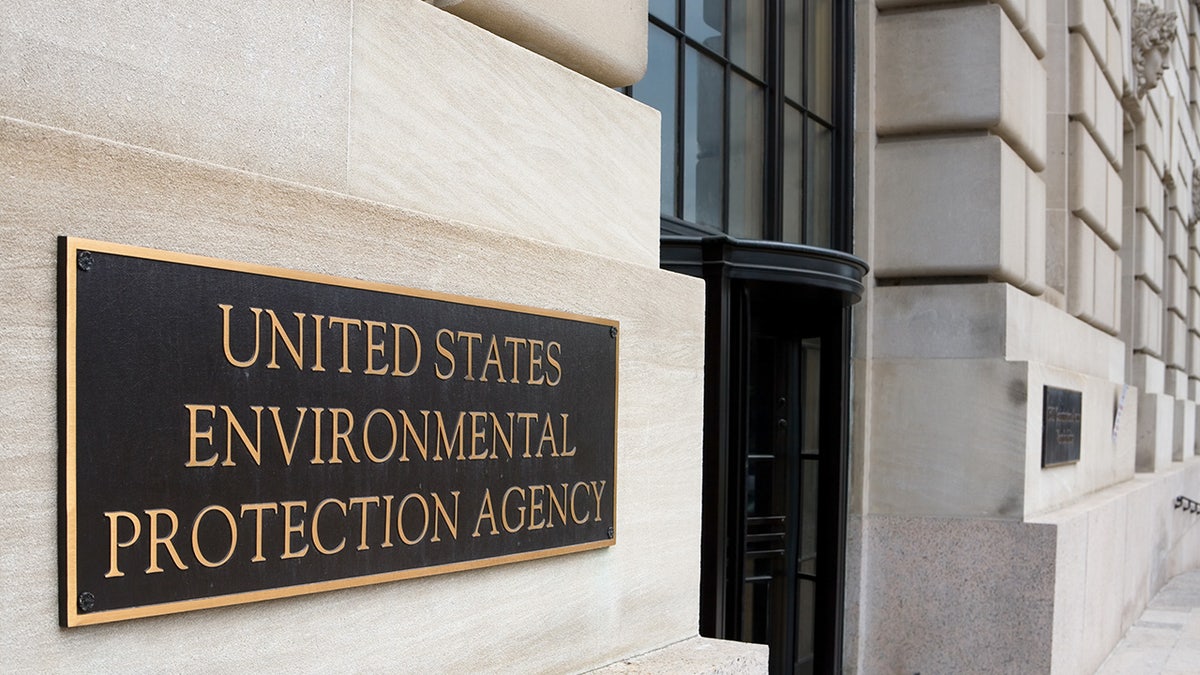
Environmental Protection Agency headquarters in Washington, D.C. (Getty)
What agencies could be targeted for cuts?
White House press secretary Karoline Leavitt told a gaggle of reporters Thursday that «thousands» of federal employees could be laid off during the shutdown.
«Look, it’s likely going to be in the thousands. It’s a very good question. And that’s something that the Office of Management and Budget and the entire team at the White House here, again, is unfortunately having to work on today,» Leavitt said.
Stern pointed to a handful of agencies that will likely be targeted for layoffs, citing agencies that have «mission creeped» their original purview into regulatory issues, such as the Environmental Protection Agency, as well as other agencies, like the National Science Foundation, that handle grant writing for programs.
«Probably the Department of Ed is, is kind of the poster child on this one,» he said. «They’ve been talking about, they quite literally only need 10% or so on the staff.»
He also noted the EPA, Department of the Interior and the Department of Labor could face cuts due to the various agencies’ «mission creep into a lot of regulations that are quite harmful to the economy, that are quite harmful to just American families.»
WHITE HOUSE TELLS FEDERAL AGENCIES TO PREPARE LAYOFF PLANS AS GOVERNMENT SHUTDOWN LOOMS
«EPA over … a decade or so, has mission creeped its jurisdiction into more and more regulatory affairs, that just simply the EPA doesn’t have under a statutory capacity,» he said. «They’re regulating outside of the confines, the charge they were given by law, by Congress. So, EPA is another one of those where that makes a lot of sense to cut a lot of the workforce there. Then, at HUD and Department of Labor you have similar things.»
Stern said the administration likely is also eyeing agencies such as the National Science Foundation, National Endowment for the Arts and Humanities and certain aspects of the Department of Housing and Urban Development that are charged with «running programs that write grants where there’s an enormous amount of legal discretion on who gets the grant money.»

President Donald Trump said the shutdown presented the opportunity for the administration to carry out layoffs as part of a continued mission to slim down the federal government. (Alex Brandon/The Associated Press )
«These grants are not serving some critical, or frankly, constitutional role,» he said, adding the grants often land in the hands of universities and promote «left-wing» ideology on topics, such as transgenderism and climate change.
What has Trump said on federal cuts?
Trump said during various public remarks Tuesday, as the deadline clock began to run dry, the shutdown presented him with the opportunity for the administration to carry out layoffs as part of a continued mission to slim down the federal government and snuff out overspending and fraud. Trump, however, repeatedly has stressed he does not support the shutdown, pinning blame on Democrats.
WHITE HOUSE PREPARES FOR ‘IMMINENT’ FEDERAL LAYOFFS AFTER DEMOCRATS FORCE GOVERNMENT SHUTDOWN
«We don’t want it to shut down because we have the greatest period of time ever,» Trump said from the Oval Office Tuesday. «I tell you, we have $17 trillion being invested. So, the last person that wants it shut down is us.
«Now, with that being said, we can do things during the shutdown that are irreversible, that are bad for them and irreversible by them, like cutting vast numbers of people out, cutting things that they like, cutting programs that they like,» he continued.
Republicans have pinned the shutdown blame on Democrats, arguing they refused to fund the budget as an attempt to reinstate taxpayer-funded medical benefits for illegal immigrants. Democrats have countered that claim as a «lie» and cast blame for the shutdown on Republicans.
«A lot of good can come down from shutdowns,» Trump added Tuesday. «We can get rid of a lot of things that we didn’t want, and they’d be Democrat things. But they want open borders. They want men playing in women’s sports. They want transgender for everybody. They never stop. They don’t learn. We won an election in a landslide.»
CLICK HERE TO GET THE FOX NEWS APP
Trump’s second administration has spotlighted the size of the federal government as bloated since Inauguration Day, including the president launching the Department of Government Efficiency to weed out potential fraud, overspending and corruption and offering federal employees voluntary buyouts in January to leave their posts before rolling out other RIF initiatives across various agencies.
Fox News Digital reached out to OMB’s office for comment on the anticipated cuts but did not immediately receive a reply.
Fox News Digital’s Elizabeth Elkind and Anders Hagstrom contributed to this report.
donald trump,budgets,white house,government shutdown
INTERNACIONAL
¿Serpiente o lagarto? El fósil que borra las fronteras evolutivas

Un equipo de paleontólogos de los Estados Unidos y Europa encontraron un fósil en la isla de Skye, en Escocia, que puede redefinir lo que se sabe sobre el origen de serpientes y lagartos modernos.
El hallazgo fue publicado en la revista Nature y consiste en los restos fósiles de una especie que llamaron Breugnathair elgolensis, un reptil que vivió hace unos 167 millones de años. Para sorpresa de los científicos, presenta características mixtas de serpiente y lagarto.
El equipo de investigación estuvo formado por especialistas del Museo Estadounidense de Historia Natural, el Museo Nacional de Escocia y el Colegio Universitario de Londres, quienes extrajeron los restos fósiles de una formación rocosa costera.
Para analizarlos, usaron microscopía, tomografías computarizadas y rayos X de alta potencia en el Sincrotrón Europeo de Radiación.

Esos métodos permitieron examinar en profundidad la morfología interna del animal sin dañar los delicados huesos. Se revelaron detalles inéditos sobre su estructura.
Breugnathair elgolensis no es exactamente una serpiente ni un lagarto moderno. Se trata de un reptil extinto que tenía características de ambos grupos. Poseía dientes curvos y mandíbulas similares a las de las serpientes, pero conservaba un cuerpo corto y patas desarrolladas, como los lagartos.
Los científicos lo ubican en una familia extinta llamada parviraptoridos, un grupo de reptiles primitivos.
El fósil muestra que los rasgos de serpiente y lagarto podían coexistir en un mismo animal, lo que sugiere que las fronteras evolutivas entre ambos grupos fueron más difusas en el pasado de lo que se pensaba.

Los ejemplares de la especie Breugnathair elgolensis vivieron hace aproximadamente 167 millones de años. Su nombre significa “falsa serpiente de Elgol”, y está relacionado con la combinación inusual de rasgos que presenta.
El ejemplar tiene mandíbulas y dientes curvados similares a los de las serpientes actuales, pero mantiene un cuerpo corto y patas completamente desarrolladas, propios de un lagarto.
Los expertos explican que este conjunto de características lo hace único entre los reptiles del pasado. Fue hallado en 2016 por Roger Benson del Museo Americano de Historia Natural y Stig Walsh del Museo Nacional de Escocia, durante una campaña de exploración. El estudio detalla que la preparación y el análisis del espécimen tardaron casi una década, debido a la fragilidad de los huesos y la dificultad para extraerlos de la roca.
El estudio en el Sincrotrón Europeo de Radiación “permitió observar detalles internos del cráneo y la dentadura sin dañar el material”, afirmó Benson.

El análisis evidenció que Breugnathair perteneció a la familia extinta de los parviraptoridos. Hasta ahora, este grupo solo se conocía por fragmentos fósiles dispersos.
El hallazgo mostró que huesos con dientes similares a serpientes y otros con rasgos de gecko, antes atribuidos a especies diferentes, en realidad coexistían en un solo animal.
“El mosaico de rasgos primitivos y especializados que observamos en los parviraptóridos es una muestra de la complejidad de la evolución”, explicó Susan Evans, coautora del trabajo.
La descripción de Breugnathair elgolensis permite describir formalmente a los parviraptóridos como una nueva familia. Antes la clasificación era solo informal.

Durante la época del Jurásico, Skye era un ambiente cálido y húmedo, integrado por archipiélagos, lagos y una amplia vegetación.
En esa zona se han encontrado fósiles de reptiles diversos, peces, dinosaurios y mamíferos primitivos.
El fósil también aporta datos sobre la evolución de los hábitos depredadores en los reptiles. Benson planteó que el origen de las serpientes podría no ser como se suponía, o bien que ciertos hábitos depredadores evolucionaron de manera independiente.
El hallazgo de Breugnathair elgolensis aporta nuevas perspectivas sobre la evolución de los reptiles escamosos y plantea más preguntas sobre el origen de las serpientes.
INTERNACIONAL
Después de que el Vesubio sepultara Pompeya, los «marginados y desfavorecidos» regresaron
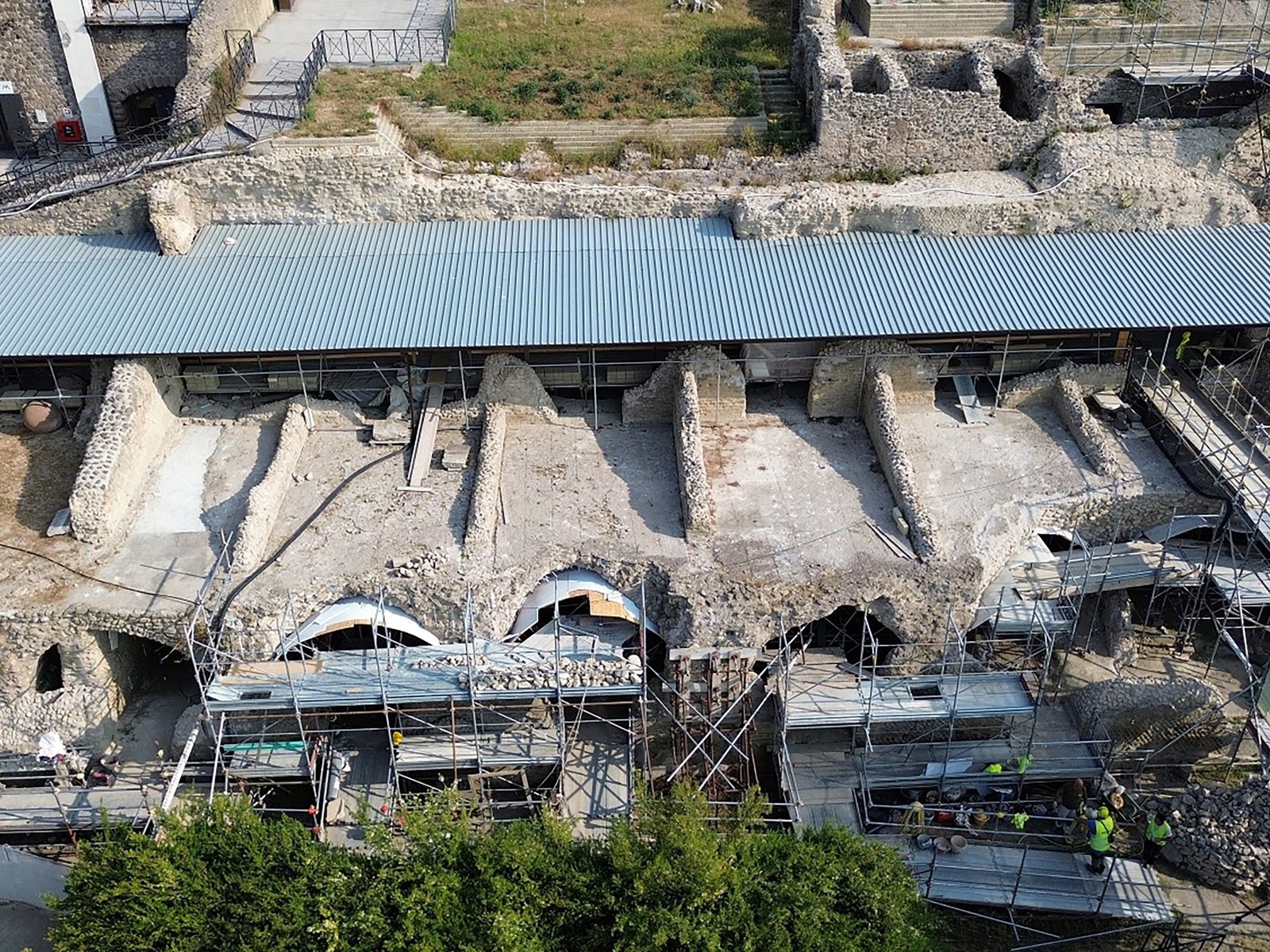
Una ruina sin caballos
De las cenizas

 POLITICA1 día ago
POLITICA1 día agoCristina Kirchner chicaneó a Javier Milei: “La Recesión Avanza y los dólares se te siguen yendo”

 CHIMENTOS3 días ago
CHIMENTOS3 días agoMario Massaccesi casó a Manu Jove y su colega de TN: los desconocidos detalles de la boda

 POLITICA23 horas ago
POLITICA23 horas agoAxel Kicillof pide deuda por US$1045 millones y pone a prueba la cohesión del PJ en la Legislatura



























